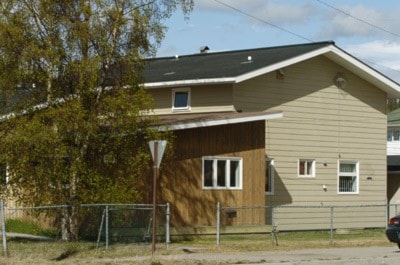Four types of mould have been found in the walls of the Yukon’s Children’s Receiving Home that houses up to 15 in-care teens and employs 12 full-time staff.
A work crew discovered the fungi while prepping the walls for a fresh coat of paint in late March, according to a property management report given to the News last week.
The home, located at 5080 Fifth Avenue in downtown Whitehorse, is run by Health and Social Services.
It can accommodate up to 15 youth, but averages eight, said Health and Social Services spokesperson Pat Living. The home employs 12 full-time staff and many on-call workers.
All moulds pose a health risk to people, according to Health Canada.
The News has been told that some workers in the home have taken sick leave, and there are suspicions it is related to the mould. However, the paper could not confirm this information.
So far this year, the Yukon Workers’ Compensation Health and Safety Board received five incident reports of injury relating to mould in the workplace.
Citing privacy concerns, the board refused to say which businesses or buildings those reports originated from.
In April, property management staff investigated several sites in the home using a borescope, which probes inside concealed spaces for the often-toxic growth.
On the stairwell to the basement they found a 15-by-10-centimetre patch on the wall’s surface. Inside the wall cavity they found another area that covered about eight square centimetres.
Samples from that spot were sent away for testing on April 18.
During that inspection process property management also found evidence of possible contamination in other places, but didn’t take any samples, according to the branch’s report dated May 9.
A “suspicious spotty discolouration” was found on the ceiling in the building’s boiler room. Staff used a borescope to look behind the ceiling board but the results were inconclusive and no samples were taken.
In the basement storage room, investigators found a 15-by-15-centimetre discolouration behind the plumbing bulkhead. But they could not get a clear view and didn’t take any samples.
“Other areas of the building were also inspected and no evidence of mould was noted,” according to the report.
“However, several locations were noted to have flaking paint, which indicates a possible moisture problem. No sampling was completed.”
The test results, received May 8, show the building contained four types of mould.
Forty per cent is Alternaria, 40 per cent is Penicillium, 10 per cent is Mucor and 10 per cent is Aspergillus, according to the report.
There are many different species of each mould and further testing is needed to determine the exact types of fungi in the home, said Pat Hogan, director of space planning and development for Yukon’s Public Works department.
The department hired Vancouver-based firm Theodor Sterling and Associates to test the mould and the building’s air quality.
“I’m not qualified to interpret it; none of the staff here are qualified to interpret it, that’s why we hired someone who has the qualifications to give us accurate information and recommendations to remediate,” said Hogan.
“When there’s the potential for a health issue, we have to find people who are qualified to do the review.”
Currently the home has a small ventilation system that only serves a few spaces.
The building is more than 30 years old.
The Highways and Public Works officials expect to receive the expert report within two weeks.
Mould affects a building’s air quality. Spores and small pieces of organic material float in the air and can be inhaled.
The smaller the particles, the deeper they penetrate into the lungs.
“There is increasing concern about the health effects of indoor mould growth because of a probable link to a wide range of symptoms and illnesses,” according to Health Canada’s website.
“After reviewing scientific evidence, Health Canada has determined that mould growth of any species in residential buildings may be hazardous to human health.”
Moulds contain a compound that can inflame people’s airways. They can also cause allergic reactions. Several produce toxic chemicals called mycotoxins which when inhaled may cause respiratory problems.
One departmental report equates the effect of mould contamination on a child to that of a parent smoking.
In December, the federal Health minister proposed residential indoor air quality guidelines for moulds.
It stated that mould growth in buildings should be prevented by controlling humidity and repairing water damage, and that any mould growing in residential buildings be thoroughly cleaned away.
“These recommendations apply regardless of the mould species to be found in the building,” it stated.
In the legislature
This week, mould problems in Mayo, the Carmacks school and the Thomson Centre became a political issue in the legislature.
What strategy does the government have to protect Yukoners’ health from mould in residences and public buildings? asked NDP MLA John Edzerza.
“(Mould) proliferates in damp conditions and needs materials found in buildings with too much humidity and improper ventilation,” said Edzerza.
“This is a common situation in the North in the winter.
“The presence of mould can ruin houses to the point of having to destroy the house and its contents.”
The government knows about the problems spores cause, responded Health Minister Brad Cathers.
“I just have to stress to the member opposite that air-quality monitoring is available and there are avenues where people can seek that if they feel there are concerns within private residences, businesses, public facilities, so on and so forth,” answered Cathers.
He repeated the same answer three times.
In the house, Cathers promised to provide Edzerza and the media with more information.
Cathers refused to be interviewed for this story.
Communications spokesman Albert Petersen promised interviews with officials familiar with the problem.
So far, the Yukon government has provided no more information.
